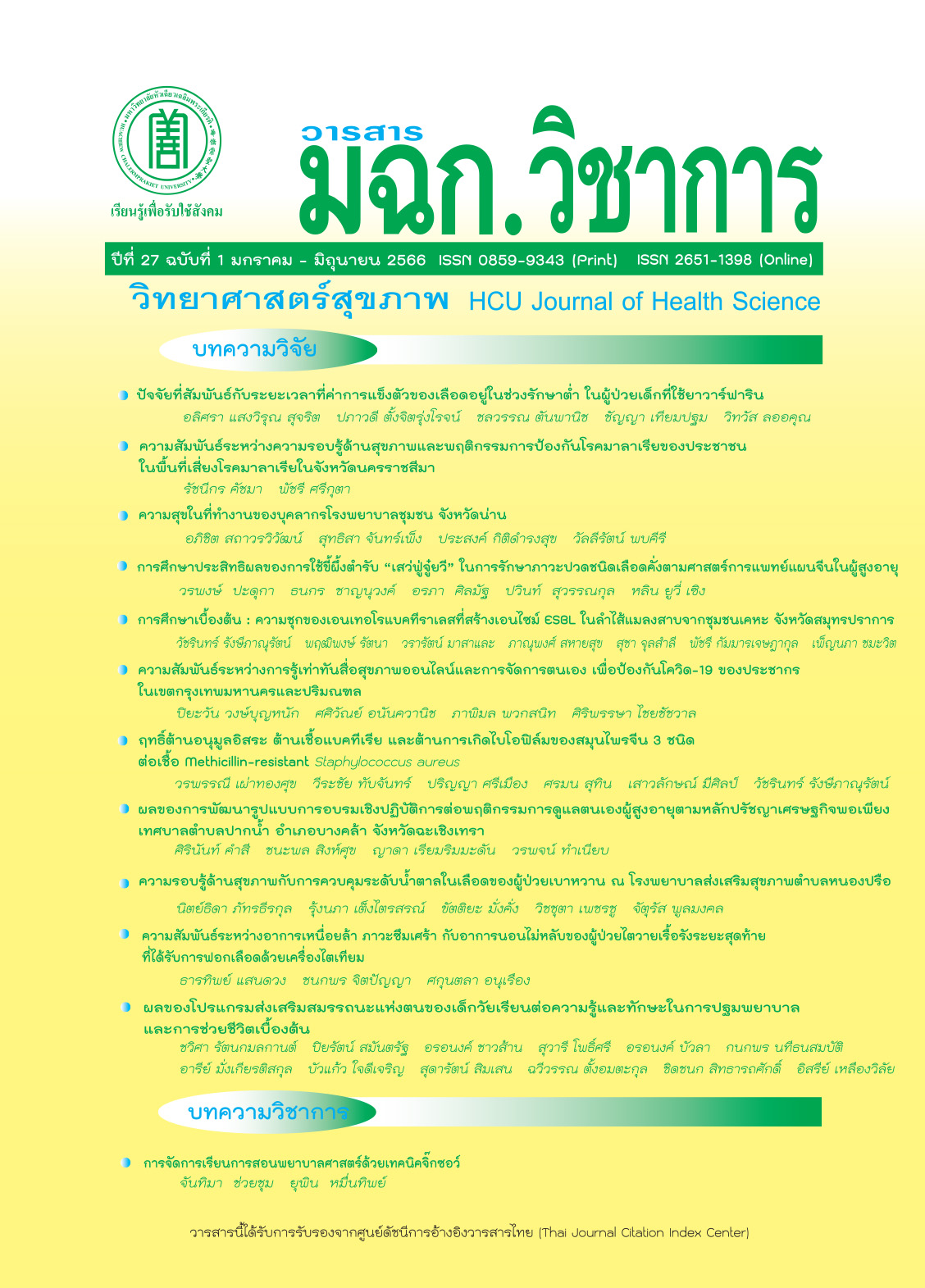Antioxidant, Antibacterial and Anti-biofilm Activities of Three Chinese Herbs against Methicillin-resistant Staphylococcus aureus
Keywords:
Huang Pai, Da Huang, Ou Mei, antioxidant, antibacterial, anti-biofilmAbstract
This study evaluated the efficacy of three Chinese herbs against methicillin-resistant Staphylococcus aureus (MRSA) and methicillin-susceptible Staphylococcus aureus (MSSA). The antioxidant, antibacterial and anti-biofilm formation of ethanol extract of three Chinese herbs including Huang Pai (Phellodendron chinensis Schneid), Da Huang (Rheum palmatum Linn.), and Ou Mei (Prunus mume (Sieb) Sieb. Et Zucc.) were evaluated. Results from antioxidant activity using DPPH radical scavenging assay showed that Da Huang had the best antioxidant with an IC50 (50% Inhibitory Concentration) value similar to the standard BHT (Butylated hydroxyl toluene). Results from the agar well diffusion and colorimetric broth microdilution tests revealed that crude extracts of Huang Pai and Da Huang had better activities than Ou Mei. The antimicrobial activity of Huang Pai against MSSA was higher than Da Huang as seen by the MIC (Minimum Inhibitory Concentration) value of 0.391 and 1.562 mg/ml, respectively. The anti-MRSA activity of both herbs’ extracts had a similar MIC value of 1.562 mg/ml. Huang Pai showed the most potent anti-biofilm effect against MSSA and MRSA with 80% inhibition of biofilm formation at 0.0244 and 0.0488 mg/ml, respectively. Results from this study illustrated that Huang Pai and Da Huang have the potential for further development into natural products treating of Staphylococcus aureus infection.
Downloads
References
Brown NM, Goodman AL, Horner C, Jenkins A, Brown EM. Treatment of methicillin-resistant Staphylococcus aureus (MRSA): updated guidelines from the UK. JAC-Antimicrob Resist [internet]. 2021 [Cited 2021 Dec 5];3(1):1-18. Available from: https://doi.org/10.1093/jacamr/dlaa114
Xu GJ, Wang Q, editors. Colors illustrations of Chinese Materia Medica. Fujian: Fujian Science and Technology Publish House; 2006.
Gao XM, editors. Chinese Materia Medica. 2nd ed. Beijing: China Press of Traditional Chinese Medicine; 2007.
Sun Y, Lenon GB, Yang AWH. Phellodendri cortex: A phytochemical, pharmacological, and pharmacokinetic review [internet]. 2019 [Cited 2021 Dec 25];7621929. Available from: http://doi.org/10.1155/2019/7621929
Feng Y, Niu MG, Zhang QW. Research progress on chemical components and pharmacological activity of Phellodendri amurensis cortex. Mod Chin Med 2021;21(8):1486-98.
Yu W, Xue Y, Xia PF, Ma X, Yang RJ, Hu JR, et al. Research progress on chemical composition and pharmacological effects of Rhei Radix et Rhizoma and predictive analysis on quality markers. Chin Tradit Herb Drugs 2019;50(19):4821-37.
Bailly C. Anticancer properties of Prunus mume extracts (Chinese plum, Japanese apricot). J Ethnopharmacol [internet]. 2020 [Cited 2021 Dec 1];10:246:112215. Available from:http://doi: 10.1016/j.jep.2019.112215
Sabayjai D, Bun-ek A, Sutin S, Sintamuth O, Nintasen R, Powtongsook W. Antibacterial, anti-biofilm and antioxidant activities of Chinese herb extracts against oral cavity bacteria. The Sci J of Phetchaburi Rajabhat University 2020;17(1):33-44.
Predner D, Hsieh PC, Lai PY, Charles AL. Evaluation of drying methods on antioxidant activity, total phenolic and total carotenoid contents of sweet potato Ipomoea batatas (Lam.) var. Tainong73. JIC 2008;3(2):73-86.
Rangsipanuratn W, Kammarnjassadakul P, Janwithayanuchit I. Antibacterial activities of ten Thai herbal extracts against Staphylococcus aureus ATCC 25923, Bacillus cereus and Escherichia coli ATCC 25922. HCU Journal 2016;19(38):35-48.
Lin NJ, Keeler C, Kraigsley AM, Ye J, Lin-Gibson S. Effect of dental monomers and initiators on Streptococcus mutans oral biofilms. Dent Mater 2018;34(5):776-85.
Daozong X, Xiaoqin W, Jiayi S, Qing Y, Ying Z. Phenolic compounds from the edible seeds extract of Chinese Mei (Prunus mume Sieb. et Zucc) and their antimicrobial activity. Food Sci Technol 2011;44(1):347-49.
Miao WG, Tang C, Ye Y. Traditional Chinese medicine extraction method by ethanol delivers drug-like molecules. CJNM [internet]. 2019 [Cited 2021 Dec 10];17(9):713-20. Available from:http://doi:10.1016/S1875-5364(19)30086-X
Mehmet B, Metin Y, Oruc A, Mirosław K, Renata F, Serap Y. Antioxidant, antibacterial and antiproliferative activities of Turkish Rhubarb (Rheum palmatum L.) leaf extracts. MDPI 2017; 1:1032.
Kim YJ, Lim HS, Kim Y, Lee J, Kim BY, Jeong SJ. Phytochemical quantification and the in vitro acetylcholinesterase inhibitory activity of Phellodendron chinense and its components. Molecules [internet]. 2017 [Cited Dec 2];22:925. Available from:http://doi:10.3390/molecules22060925
Yan X, Gu S, Shi Y, Cui X, Wen S, Ge J. The effect of emodin on Staphylococcus aureus strains in planktonic form and biofilm formation in vitro. Arch Microbiol 2017;199(9):1267-75.
Pojanaukij N, Kajorncheappunngam S. Comparison of antimicrobial activity of mangosteen crude, turmeric and gotu kola extract. NUJ 2010;18(1):1-9.
Suwannakul S, Yuankyong S, Masi K, Nanbunta P, Burirak P. Antibacterial activities of Iicorice extract on biofilms and planktonic cells of Staphylococcus aureus. NUJST 2014;22(1):80-90.
Aly MM, Gumgumjee NM. Antimicrobial efficacy of Rheum palmatum, Curcumalonga and Alpinia officinarum extracts against some pathogenic microorganisms. Afr J Biotechnol 2011;10(56):12058-63.
Kim G, Gan R, Zhang D, Farha AK, Habimana O, Mavumengwana V, et al. Large-scale screening of 239 traditional Chinese medicinal plant extracts for their antibacterial activities against multidrug-resistant Staphylococcus aureus and cytotoxic activities. Pathogens [internet]. 2020 [Cited 2021 Dec 6];9:185. Available from:http://doi:10.3390/pathogens9030185
Lee YS, Kang OH, Choi JG, Oh YC, Keum JH, Kim SB, et al. Synergistic effect of emodin in combination with ampicillin or oxacillin against methicillin-resistant Staphylococcus aureus. Pharm Biol 2010;48(11):1285-90.
Downloads
Published
How to Cite
Issue
Section
License
Copyright (c) 2023 HCU Journal

This work is licensed under a Creative Commons Attribution-NonCommercial-NoDerivatives 4.0 International License.
บทความที่ได้รับการตีพิมพ์เป็นลิขสิทธิ์ของวารสารวิทยาศาสตร์สุขภาพและสุขภาวะ
ข้อความที่ปรากฏในบทความแต่ละเรื่องในวารสารวิชาการเล่มนี้เป็นความคิดเห็นส่วนตัวของผู้เขียนแต่ละท่านไม่เกี่ยวข้องกับมหาวิทยาลัยหัวเฉียวเฉลิมพระเกียรติ และคณาจารย์ท่านอื่นๆในมหาวิทยาลัยฯ แต่อย่างใด ความรับผิดชอบองค์ประกอบทั้งหมดของบทความแต่ละเรื่องเป็นของผู้เขียนแต่ละท่าน หากมีความผิดพลาดใดๆ ผู้เขียนแต่ละท่านจะรับผิดชอบบทความของตนเองแต่ผู้เดียว




